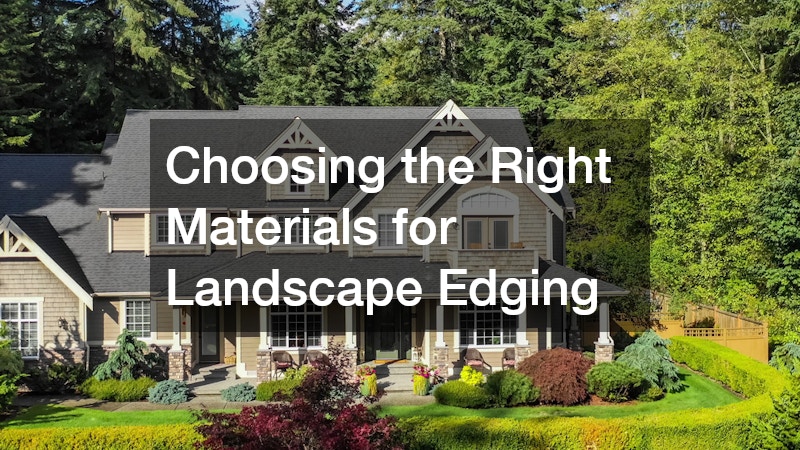Essential Facts About Landscape Edging Every Homeowner Should Know
Landscape edging is a critical component of garden and landscape design that serves both functional and aesthetic purposes. It is typically defined as the process of creating distinct borders between different areas of your garden or yard, such as between plant beds and lawns, paths, or driveways. This not only helps to keep mulch, soil, or rocks contained but also prevents grass from spreading into unwanted areas, ensuring that your garden looks neat and well-organized.
The variety of materials available, such as plastic, metal, stone, or wood, allows for customization to complement the overall landscape design. Moreover, well-installed landscape edging can add significant visual appeal, making your outdoor space more inviting and professional-looking.
Importantly, landscape edging can increase the property value by enhancing curb appeal. An investment in quality edging materials and design tailored to your property can pay off when the time comes to sell your home. Potential buyers are often drawn to properties with well-maintained and visibly appealing outdoor spaces. As a result, many homeowners find that spending a little more upfront on durable and visually appealing edging can be a wise economic decision. Consequently, landscape edging should not only be seen as a way to maintain order in your garden but also as a lucrative investment in your property’s overall value.
Another remarkable benefit of landscape edging is its role in reducing garden maintenance. With clearly defined edges, the task of mowing the lawn, trimming shrubs, and pulling weeds becomes significantly easier. The barriers created by edging act as a deterrent for roots and weeds, which means fewer gardening chores and more time spent enjoying your outdoor space. Furthermore, the separation of different elements in the garden enhances their individual appearance; for example, green grass vividly stands out next to flowerbeds if there is a clear demarcation. Therefore, landscape edging can be seen not only as a stylistic choice but as a practical solution to maintaining a beautiful garden with reduced effort.
Choosing the Right Materials for Landscape Edging

Selecting the best materials for landscape edging is crucial as they directly affect the durability and cosmetic appeal of your garden space. Plastic edging, for instance, is affordable and easy to install, suitable for curvy designs and temporary setups, yet may not offer the same aesthetic appeal as other options. On the other hand, materials like brick and stone, although more expensive, provide a natural look and are extremely durable, capable of withstanding harsh weather conditions over the years. For homeowners seeking a modern touch, metal edging can offer a sleek finish, with options like aluminum or steel that resist rust and deterioration. The choice of material will ultimately depend on your budget, design preferences, and maintenance capabilities.
When it comes to eco-friendly options, wood edging is a popular choice. However, it requires regular upkeep to prevent rot and termite infestation. Cedar and redwood are among the better options for wood since they naturally resist decay, making them a sustainable option for environmentally conscious homeowners. Furthermore, using repurposed materials can provide unique, custom borders that also reduce environmental impact. These sustainable choices serve not only to protect the natural environment but can also offer a personalized flair to your garden design. Whatever material you choose, ensure that it aligns with the style of your home and its surrounding environment.
It is equally important to consider the landscape’s climatic conditions when choosing edging materials. For instance, metal and stone are ideal for areas with extreme temperature fluctuations, as they will withstand the elements without warping or breaking down. In contrast, plastic may become brittle in cold temperatures or fade under intense sunlight, making it a less sustainable long-term option. Installing landscape edging that complements the climate will ensure your garden remains attractive and functional throughout the seasons. Also, remember to think about the ease of installation; while some materials may require professional installation, others can be easily done as a DIY project.
Installation Tips and Maintenance for Landscape Edging
Successful landscape edging installation begins with thorough planning and preparation. Measure the area carefully to determine the amount of material needed, and consider the existing landscape and any future gardening plans that may affect the layout. Clear any debris and ensure the ground is level where the edging will be placed to prevent uneven sinking or warping of the materials. The next step is to dig a trench along the proposed edge line; this will help to secure the edging and prevent it from shifting. Whether you are using plastic, stone, or any other material, proper installation is vital to ensure the longevity and effectiveness of the landscape edging.
Maintaining your landscape edging is equally important to preserve its functionality and appearance. Regularly inspect the edges for any signs of wear, damage, or displacement, especially after severe weather conditions. Stones or bricks may occasionally need repositioning, while plastic or wood may require replacement over time. Keeping the edges clean of debris and weeds will help maintain their neat appearance and prevent moisture buildup that could lead to rot or rust. Moreover, proper maintenance of the materials will prolong their lifespan, ensuring your investment continues to enhance your garden for years to come.
Finally, integrating landscape edging into your regular garden maintenance routine will ensure that your outdoor space remains attractive and orderly. Consider designating a specific time each season to assess and refresh your edging as needed, which prevents minor issues from developing into more significant problems. Incorporate new plants or garden features with plans for additional or adjusted edging to maintain harmony throughout the growing seasons. Professional landscapers can provide you with additional insights and techniques to maintain your space. With knowledge and care, landscape edging will significantly enhance your garden’s aesthetics and functionality, benefiting homeowners and garden enthusiasts alike.
